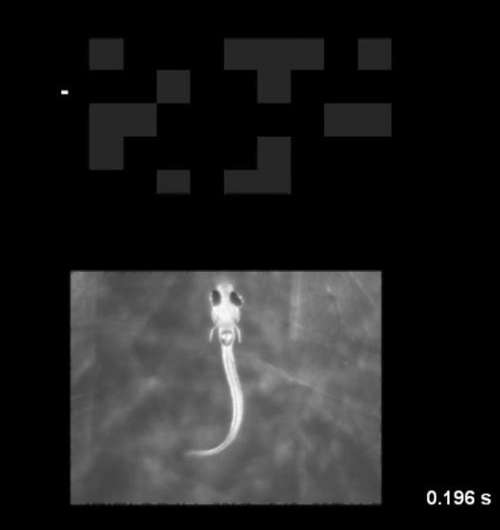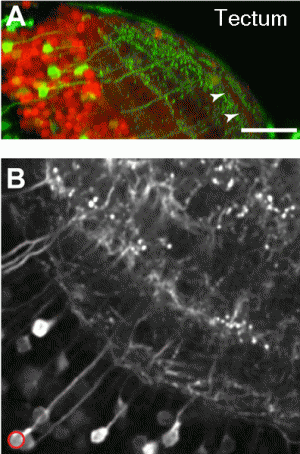Researchers analyse hunting behaviour of fish larvae in virtual reality

Moving objects attract greater attention – a fact exploited by video screens in public spaces and animated advertising banners on the Internet. For most animal species, moving objects also play a major role in the processing of sensory impressions in the brain, as they often signal the presence of a welcome prey or an imminent threat. This is also true of the zebrafish larva, which has to react to the movements of its prey. Scientists at the Max Planck Institute for Medical Research in Heidelberg have investigated how the brain uses the information from the visual system for the execution of quicker movements. The animals' visual system records the movements of the prey so that the brain can redirect the animals' movements through targeted swim bouts in a matter of milliseconds. Two hitherto unknown types of neurons in the mid-brain are involved in the processing of movement stimuli.
In principle, the visual system of zebrafish larvae resembles that of other vertebrates. Moreover, its genome has been decoded, it is a small organism, and it has transparent skin, which is easily penetrated by light in the fluorescent microscope. Therefore, these animals are very suitable for studying visual motion perception. They also display very clear prey capture behaviour. With the help of their finely-tuned visual system, they pursue and catch small ciliates. To do this, they execute a series of swimming manoeuvres in a matter of one or two seconds, during which they repeatedly verify the direction and distance of the prey so that they can adapt their subsequent movement steps. The larva's brain must, therefore, filter and evaluate visual information extremely rapidly so that it can select appropriate motor patterns.
Using high-speed video recordings, researchers working with Johann Bollmann at the Max Planck Institute for Medical Research began by studying the natural course of prey capture by the larvae under a variety of starting conditions. It emerged that the larvae repeatedly execute a basic motion pattern and can apply an orientation component that re-directs the hunter towards the prey with each swim bout. To do this, the larvae must process visual information in just a few hundreds of milliseconds.
Using an innovative experimental design, the scientists then modelled, in a second step, the natural swimming environment as a "virtual reality", in which the larvae execute typical prey capture sequences without actually moving. The virtual prey consisted of computer-controlled images, which were projected onto a small screen. In this way, the role of motion parameters, for example the size and speed of the "prey", could be studied quantitatively in relation to the processing of visual stimuli by the animals.

In the "virtual reality", the scientists can test how the fish larvae respond to unexpected shifts in the prey after a swim bout. "When we direct our gaze at a target through movements of our eyes and head, we expect the object to appear in a central position in our field of view. In the larvae, very slight deviations from the target position or delays in the re-appearance of the virtual prey increased the reaction times. When it receives unexpected visual feedback, the larva's brain presumably needs extra processing time to calculate the next swim bout," explains Johann Bollmann from the Max Planck Institute in Heidelberg.
In addition, with the help of fluorescent microscopes, the researchers can examine the activity of groups of neurons in the larval brain which are likely to control the targeted prey capture movements. In a previous study, they discovered cell types that react specifically to opposing directions of movement. These previously unknown neurons in the dorsal region of the midbrain (tectum) differ in their directional sensitivity and in the structure of their finely branched projections. "It appears that different directions of motion are processed in different layers of the tectum, since the dendritic ramifications of these cell types are spatially separated from each other," says Bollmann.
More information: Trivedi, C. A.; Bollmann, J. H. Visually driven chaining of elementary swim patterns into a goal-directed motor sequence: a virtual reality study of zebrafish prey capture, Frontiers in Neural Circuits 7, 86 (2013)
Gabriel, J. P.; Trivedi, C. A.; Maurer, C. M.; Ryu, S.; Bollmann, J. H. Layer-specific targeting of direction-selective neurons in the zebrafish optic tectum Neuron 76, 1147-1160 (2012)


















